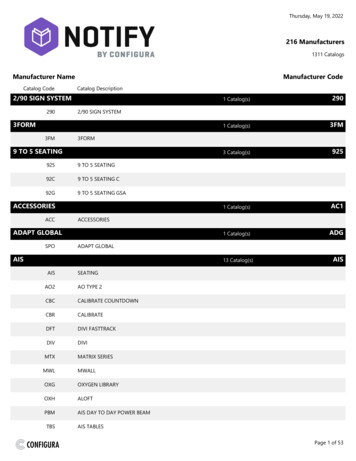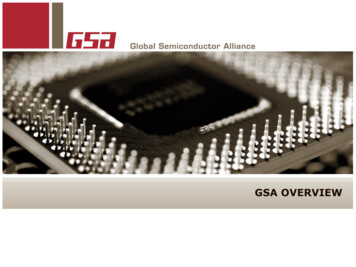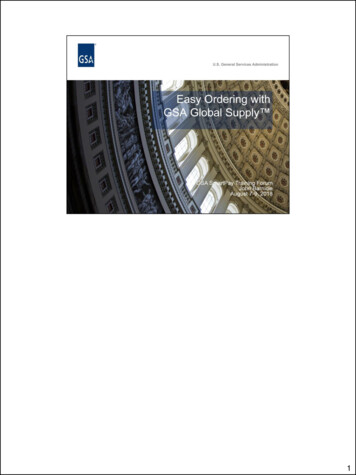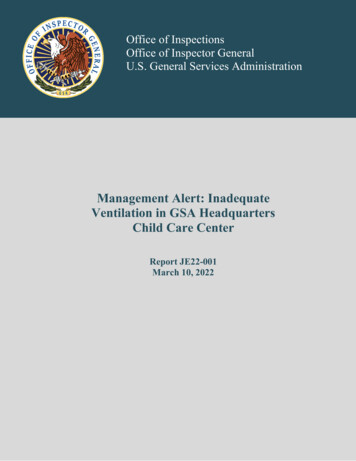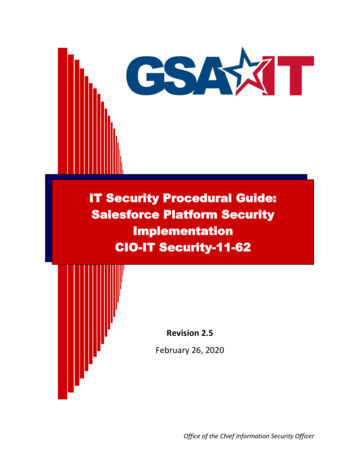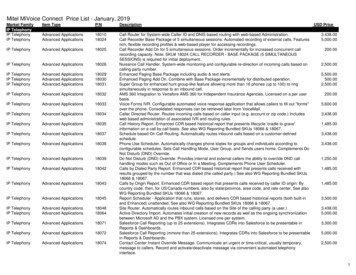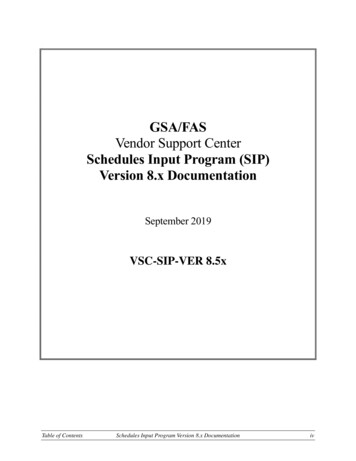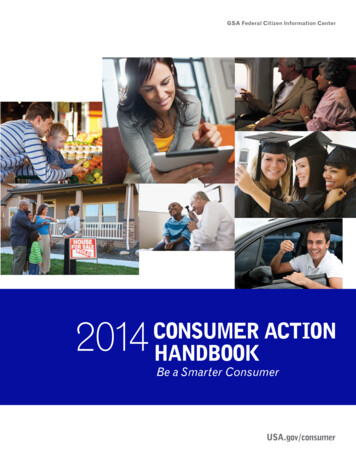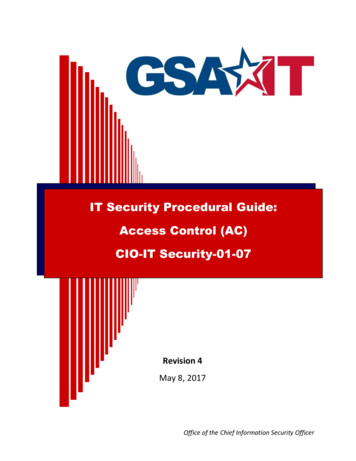
Transcription
General Services AdministrationWashington, DC 20405ADM 2800.12B, Change 135September 28, 2021GSA ORDERSubject:General Services Administration Acquisition Manual; GSAM Case 2021G511, Cyber-Supply Chain Risk Management (C-SCRM) IncidentResponse and Risk Information Sharing1. Purpose. This order transmits a revision to the General Services AdministrationAcquisition Manual (GSAM) to improve acquisition-related incident responseprocedures and notification processes, outline GSA’s Supply Chain Risk Informationsharing process, and to update the GSAM to reflect a focus on Cyber-Supply ChainRisk Management (C-SCRM).2. Background. A series of recent policy changes internal and external to GSA havehighlighted the importance of the Federal Government’s goal to improve its C-SCRMresponse and preparedness. This order reflects GSA’s commitment to help meetthat goal by establishing GSA-specific procedures for coordinating and assessingadditional supply chain risks on GSA contracts.Internal Policies:In April 2021, GSA issued it’s Cyber-Supply Chain Risk Management (C-SCRM)Strategic Plan 1 (the “Plan”). As outlined in the Plan, though GSA already has arobust information technology (IT) governance scheme, acquisition policy (inaddition to the IT governance) must continually be updated to address the changingand growing nature of supply chain risks, including cyber supply chain risks. ThisGSAM amendment reflects one step in updating our acquisition policy to address CSCRM.External Policies:On May 12, 2021, Executive Order (EO) 14028, Improving the Nation’sCybersecurity, was issued. This EO states, “The United States faces persistent andincreasingly sophisticated malicious cyber campaigns that threaten the public sector,the private sector, and ultimately the American people’s security and privacy.” Ithighlights that the Federal Government must improve its efforts to identify, deter,protect against, detect, and respond to these cyber threats. While additionalrulemaking and guidance from the Federal Acquisition Regulatory Council and otherresponsible agencies will be forthcoming as a result of this EO, GSA is taking aproactive approach to amending our specific acquisition policy to help meet therequirements of the EO.On December 21, 2018, the Federal Acquisition Supply Chain Security Act of 2018(the “Act”) was signed into law. The Act requires all Executive Branch agencies to1Version 1.3, dated March 29, 2021, approved April 13, 2021Page 1
establish a formal program and to conduct supply chain risk assessments 2. Whileimplementation guidance from the Federal Acquisition Security Council (FASC) established through the Act - is forthcoming, GSA is again taking proactive steps tostart an information sharing process.3. Effective date. September 28, 20214. Explanation of changes. The amendment changes are non-regulatory changes. Forfull text changes of the amendment see Attachment A, GSAM Text Line-In/Line-Out.This amendment revises the language of the following GSAM subparts (titles reflectamended changes). Specific amendments are explained below. 504.70 (Cyber-Supply Chain Risk Management)504.7000 (Scope of Subpart)504.7001 (Definitions)504.7002 (Policy)504.7003 (General Procedures)504.7005 (Notification Procedures for Cyber-Supply Chain Events)Amend subpart 504.70 by: Amending the subpart heading by adding “Cyber-” in front of “SupplyChain Risk Management”. GSAM subpart 504.70 is updated to reflect afocus on C-SCRM.Amend section 504.7000 by: Updating to reflect the focus on “cyber” supply chain management,remove the concentration on only the post-award phase, and specify thetypes of contracts and orders to which these procedures apply.Amend section 504.7001 by: This section is updated to add or amend the following definitions: Adding a definition for “Cyber-Supply Chain Event”. Adding a definition for “Cyber-Supply Chain Risk Management”. Adding a definition for “Cyber-Supply Chain Management PolicyAdvisor”. Adding a definition for “IT security incident”. Updating the definition of “Prohibited article”. Adding a definition for “Prohibited source”. Adding a cross-reference to the definition of “Supply chain riskinformation”. Adding a definition for “Substantial supply chain risk information”.Amend section 504.7002 by:2The Federal Acquisition Supply Chain Security Act of 2018 is Title II of the SECURE Technology Act (P.L.115-390) (Dec. 21, 2018).Page 2
Updating to reflect new policies applicable to C-SCRM.Amend section 504.7003 by: Updating to reflect the responsible groups for resolving Cyber-SupplyChain Events.Amend section 504.7005 by: Simplifying the process the acquisition workforce must go through tonotify the responsible GSA office of a cyber-supply chain event 3. Insteadof acquisition workforce members having to determine the properdefinition, or identifying the proper location to submit a notification, newlanguage added at 504.7005 highlights the utilization of a “one-entrypoint” system. In short, a notification - for any event recognized in thesubpart - will go to the GSA IT Service Desk. The IT Service Desktechnician will help identify the type of event and notify the responsibleparty. This will alleviate the acquisition workforce from the responsibility ofdetermining where to submit various notifications.Adding requirements to share supply chain risk information (including forboth C-SCRM and non-C-SCRM risks), to reflect GSA’s commitment tosharing relevant information with the FASC.5. Point of contact. For clarification of content, contact Stephen Carroll, GSAAcquisition Policy Division, at gsarpolicy@gsa.gov.signed byJEFFREY DigitallyJEFFREY KOSESDate: 2021.09.27KOSES 12:21:10 -04'00'Jeffrey KosesSenior Procurement ExecutiveOffice of Acquisition PolicyOffice of Government-wide Policy3“Cyber-Supply Chain Event” is now defined through this amendment at GSAM 504.7001.Page 3
GSAM Case 2021-G511GSAM Text, Line-In/Line-OutGSAM Baseline: Change 134 effective 09/08/2021 Additions to baseline made by rule are indicated by [bold text inbrackets] Deletions to baseline made by rule are indicated by strikethroughs Five asterisks (*****) indicate that there are no revisions between thepreceding and following sections Three asterisks (***) indicate that there are no revisions between thematerial shown within a subsectionPART 504—ADMINISTRATIVE MATTERS*****Subpart 504.70—[Cyber-]Supply Chain Risk Management504.7000 Scope of subpart.This subpart prescribes acquisition policies and procedures [for]mitigating [cyber-] supply chain risks in the post-award phase of aprocurement[s] funded by GSA. Procedures in this subpart apply to all GSA[-]funded contracts and orders[,]. These procedures apply regardless of theestimated value of the [solicitation,] contract[ or order, including purchasesunder the micro-purchase threshold and purchases using a GovernmentPurchase Card].504.7001 Definitions.[“Cyber-Supply Chain Event” means any situation or occurrence in or to anetwork, information system, or within the supply chain, not purchased onbehalf of another agency, that has the potential to cause undesirableconsequences or impacts. Cyber-Supply Chain Events, as they relate tothis subpart, can include:(a) Occurrence of an IT security incident;(b) Discovery of a prohibited article or source; and(c) Identification of supply chain risk information.Page 4
“Cyber-Supply Chain Risk Management”, or “C-SCRM”, meansmanagement of cyber-related (or, more generally, technology-related) risksin all phases of the acquisition lifecycle and at all levels of the supplychain, regardless of the product(s) or service(s) procured.“Cyber-Supply Chain Risk Management Policy Advisor” means theidentified lead of the Service-level acquisition management (e.g., theFederal Acquisition Service’s Office of Policy and Compliance (OPC), thePublic Building Service’s Office of Acquisition Management (OAM), theOffice of Administrative Services).“IT security incident” means an occurrence that:(a) Actually or imminently jeopardizes, without lawful authority, theintegrity, confidentiality, or availability of information or an informationsystem;(b) Constitutes a violation or imminent threat of violation of law,security policies, security procedures, or acceptable use policies;(c) Results in lost, stolen, or inappropriately accessed ControlledUnclassified Information (CUI) (including Personally IdentifiableInformation (PII)), lost or stolen GSA-owned devices (mobile phones,laptops, Personal Identity Verification (PIV) cards), and any other incidentincluded in CIO-IT-Security-01-02); or(d) Results in a situation that severely impairs, manipulates, or shutsdown the operation of a system or group of systems (e.g., BuildingAutomation Systems, Heating, Ventilation, Air Conditioning (HVAC)systems, Physical Access Control Systems (PACS), Advanced MeteringSystems, Lighting Control Systems).]“Prohibited article” means any prohibited product, system, or service that thecontractor [offers or ]provides [to the Government ]that conflicts with thesupply chain terms or conditions of the [solicitation or ]contract (e.g., [FederalAcquisition Security Council (FASC) exclusion order, ]GSA CIO Order,counterfeit items, a FAR [provision or ]clause, including[,] without limitation[,]the FAR Clause at 52.204-23, Prohibition on Contracting for Hardware, Software,Products and Services Developed or Provided by Kaspersky Lab and OtherPage 5
Covered Entities[, FAR Provision at 52.204-24, Representation RegardingCertain Telecommunications and Video Surveillance Services orEquipment, and FAR Clause at 52.204-25, Prohibition on Contracting forCertain Telecommunications and Video Surveillance Services orEquipment]).[“Prohibited source” means any entity with which the Government may notenter into or renew a contract or from which the Government may notpurchase products or services due to conflicts with the supply chain termsor conditions of the solicitation or contract (e.g., FASC exclusion order,GSA CIO Order, FAR provision or clause, contract-specific provision orclause).]“Supply chain” means a linked set of resources and processes between multipletiers of developers that begins with the sourcing of products and services andextends through the design, development, manufacturing, processing, handling,and delivery of products and services to the acquirer.[“Supply chain risk information” is defined at 41 C.F.R. 201.102(q). Failureof an offeror to meet a solicitation’s requirements, including securityrequirements, will not by itself constitute supply chain risk information.“Substantial supply chain risk information” means supply chain riskinformation that leads to any of the following:(a) Removal of a presumptive awardee from pre-award considerationor competition;(b) Rejection of a proposed subcontractor;(c) Removal of a subcontractor from a contract; or(d) Termination of a contract.]504.7002 Policy.(a) The Federal Information Security Modernization Act of 2014 [(PublicLaw 113-283) ]and associated National Institute of Standards and Technology(NIST) guidance requires Federal agencies to manage supply chain risks forFederal information systems[ and to ensure the effectiveness of informationsecurity controls and risks].Page 6
(b) OMB Circular A-130, “Managing Information as a Strategic Resource,”directs agencies to implement supply chain risk management principles to protectagainst the insertion of counterfeits, unauthorized production, tampering, theft,insertion of malicious software, as well as poor manufacturing and developmentpractices throughout the system development life cycle.(c) The SECURE Technology Act (Public Law 115-390)[, which includesthe Federal Acquisition Supply Chain Security Act of 2018, established theFederal Acquisition Security Council (FASC) to improve executive branchcoordination, supply ch uisition team member thinks supply chainrisk information should be shared with the FASC, the contracting officer oranother acquisition team member must contact the GSA IT Service Deskwho will gather relevant information and share it with the appropriateCyber-Supply Chain Risk Management Policy Advisor.Page 11
(i) Service-level policy may adopt additional procedures toprovide acquisition team members with guidance prior to notifying the GSAIT Service Desk.(3) After initial notification, the appropriate Cyber-Supply ChainRisk Management Policy Advisor may request additional information andwill work with the notifier to resolve the issue.(4) The Cyber-Supply Chain Risk Management Policy Advisors willshare information with the Office of Acquisition Policy within OGP. Ifdeemed appropriate, OGP will share the information with the FASC.(i) The Office of Acquisition Policy within OGP will disseminateany supply chain risk information shared by the FASC to the relevant GSAoffices and personnel.]([e]b) [Cyber-]Supply Chain Event Risk Mitigation. The contractadministration procedures under FAR part 49 (e.g., cure notice, termination forcause, past performance review) can be u[s]tilized as needed to addressimmediate or future supply chain event concerns. Additional guidance oncontract administration procedures is available on the GSA Acquisition Portal(http://insite.gsa.gov/[c]scrm)([f]c) Past Performance Evaluation. The contracting officer [must]shallreport any contractor non-compliance with supply chain requirements within the“Other Areas” portion of any applicable past performance evaluation form.*****Page 12
full text changes of the amendment see Attachment A, GSAM Text LineIn/Line- -Out. This amendment revises the language of the following GSAM subparts (titles reflect amended changes). Specific amendments are explained below. 504.70 (Cyber-Supply Chain Risk Management) 504.7000 (Scope of Subpart) 504.7001 (Definitions)
